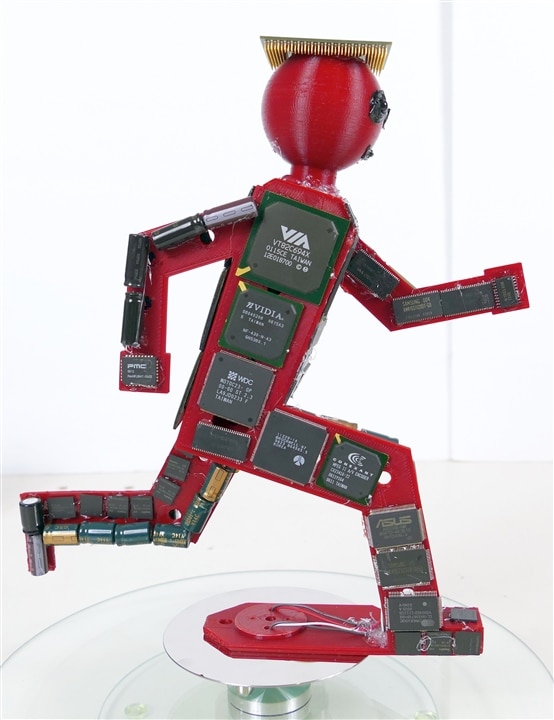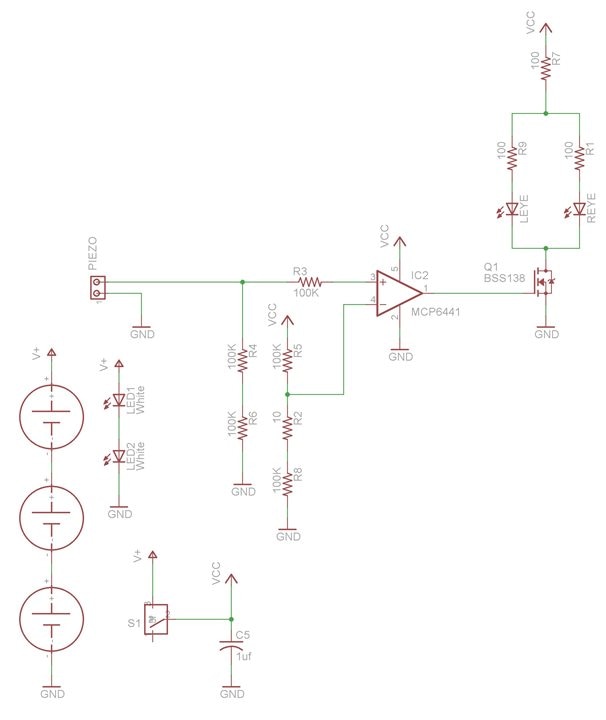Intro
This part of the upcycling design challenge is about making use of obsolete but iconic integrated circuits. We don't usually see the chips that make our computers work, so I thought I would extract them and showcase them in a work of art which captures the hardware essence of the PC phenomenon in a 6 dimensional sculpture. The iconic chips used in this PC characterize the maturing PC revolution at the turn of the century. The corporate branding on the various chips really resonate with people who were immersed in the PC revolution, particularly because famous peripherals had the same branding.
Technical Symbology
Brand names on the big chips from this PC really illustrate the core technologies that comprise the soul of a PC at the turn of the century.
The primary symbology of the iconic "running man" sculpture is that it represents the perpetually running Pentium supported by key peripheral ICs.
There are also other symbologies embodied in the design:
- The hard disk mounting plate symbolically holds a 3 dimensional database of core PC technologies, and it can also spin forever on its solar powered turntable.
- Each of the chips symbolize important features that were part of the PC ethos, and their integration into a single device opened up vast capabilities. This is why they were all included in the sculpture.
Mr Pentium aka Running Man

Not only is the sculpture a 3 dimensional visual work of art that evokes memories and intellectual concepts, it is also responds interactively to external stimuli, and it does it without batteries or external power connections.
At the start, I called it a 6 dimensional sculpture.
The first 3 dimensions don't need much explanation, although the sculpture transforms a classic 2D running man icon firmly into the real 3 dimensional world.
The fourth dimension is always time which is crucial in a perpetually running computer, in this case the solar rotating pedestal presents an infinite number of visual angles over time.
The fifth dimension in this case is that the sculpture is interactive, it responds to external stimuli with its eyes which can light up in response to vibration.
The sixth dimension is purely intellectual; the sculpture evokes memories, feelings and concepts that are much larger than the physical sculpture itself. This sixth dimension is different for each viewer, and it is the primary reason why I made the sculpture. I knew it would evoke powerful memories and feelings in me.
The Mr. Pentium Video
The Schematic

This circuit amplifies any small signal from a piezo disk to turn on some LEDs. The power is supplied by 3 photovoltaic cells in series which charge a 1000µf capacitor. The voltage is regulated by 2 white LEDs in series across the capacitor, so when the voltage exceeds 5 volts they start to conduct and prevent the voltage from exceeding 6 volts.
Discussion
This recycling/upcycling project goes all the way down to the chip level in this episode, building a sculpture from obsolete chips. It isn't just a static sculpture though, it is animated and interactive, with both of these features being solar powered. It takes the concept of a perpetually running Pentium to the next level, implementing continuous operation without batteries or external power.
The sculpture design started with some CAD work based on popsicle sticks. It then shifted to several days of gluing sticks together, however it was so tedious waiting for glue to dry that I switched to designing a 3D printed frame based loosely on a scaled version of my own body dimensions.
The perfectly circular, perfectly polished hard disk platter used in the base is not very photogenic, but it in person it really adds a sense of high class and high quality to the sculpture.
Viewers will have their own take on this work, but for me it represents an intriguing way to preserve and highlight some of the core technologies that greatly affected my life and career in a positive way.
This little project saved some obsolete chips from being worthless to preserving something priceless.
How did the PC revolution affect your life and how do you commemorate it?

-

genebren
-
Cancel
-
Vote Up
0
Vote Down
-
-
Sign in to reply
-
More
-
Cancel
Comment-

genebren
-
Cancel
-
Vote Up
0
Vote Down
-
-
Sign in to reply
-
More
-
Cancel
Children